| Potato | |
|---|---|
 | |
| Scientific classification | |
| Kingdom: | Plantae |
| (unranked): | Angiosperms |
| (unranked): | Eudicots |
| (unranked): | Asterids |
| Order: | Solanales |
| Family: | Solanaceae |
| Genus: | Solanum |
| Species: | S. tuberosum |
| Binomial name | |
| Solanum tuberosum L. | |
Wild potato species occur throughout the Americas, from the United States to Uruguay.[3] The potato was originally believed to have been domesticated independently in multiple locations,[4] but later genetic testing of the wide variety of cultivars and wild species proved a single origin for potatoes in the area of present-day southern Peru (from a species in the Solanum brevicaule complex), where they were domesticated 7,000–10,000 years ago.[5][6][7] Following centuries of selective breeding, there are now over a thousand different types of potatoes.[6] Of these subspecies, a variety that at one point grew in the Chiloé Archipelago (the potato's south-central Chilean sub-center of origin) left its germplasm on over 99% of the cultivated potatoes worldwide.[8][9]
Following the Spanish conquest of the Inca Empire, the Spanish introduced the potato to Europe in the second half of the 16th century. The staple was subsequently conveyed by European mariners to territories and ports throughout the world. The potato was slow to be adopted by distrustful European farmers, but soon enough it became an important food staple and field crop that played a major role in the European 19th century population boom.[7] However, lack of genetic diversity, due to the very limited number of varieties initially introduced, left the crop vulnerable to disease. In 1845, a plant disease known as late blight, caused by the fungus-like oomycete Phytophthora infestans, spread rapidly through the poorer communities of western Ireland, resulting in the crop failures that led to the Great Irish Famine. Nonetheless, thousands of varieties persist in the Andes, where over 100 cultivars might be found in a single valley, and a dozen or more might be maintained by a single agricultural household.[10]
The annual diet of an average global citizen in the first decade of the 21st century included about 33 kg (73 lb) of potato. However, the local importance of potato is extremely variable and rapidly changing. It remains an essential crop in Europe (especially eastern and central Europe), where per capita production is still the highest in the world, but the most rapid expansion over the past few decades has occurred in southern and eastern Asia. China is now the world's largest potato-producing country, and nearly a third of the world's potatoes are harvested in China and India.[11]
Contents
|
Etymology
"Spud" redirects here. For other uses, see Spud (disambiguation).
The English word potato comes from Spanish patata (the name used in Spain). The Spanish Royal Academy says the Spanish word is a compound of the Taino batata (sweet potato) and the Quechua papa (potato).[12] The name potato originally referred to a type of sweet potato rather than the other way around, although there is actually no close relationship between the two plants. The English confused the two plants one for the other. In many of the chronicles detailing agriculture and plants, no distinction is made between the two.[13] The 16th-century English herbalist John Gerard used the terms "bastard potatoes" and "Virginia potatoes" for this species, and referred to sweet potatoes as "common potatoes".[14] Potatoes are occasionally referred to as "Irish potatoes" or "white potatoes" in the United States, to distinguish them from sweet potatoes.[14]The name spud for a small potato comes from the digging of soil (or a hole) prior to the planting of potatoes. The word is of unknown origin and was originally (c. 1440) used as a term for a short knife or dagger, probably related to Dutch spyd and/or the Latin "spad-" root meaning "sword"; cf. Spanish "espada", English "spade" and "spadroon". The word spud traces back to the 16th century. It subsequently transferred over to a variety of digging tools. Around 1845 it transferred over to the tuber itself.[15] The origin of "spud" has erroneously been attributed to a 19th century activist group dedicated to keeping the potato out of Britain, calling itself The Society for the Prevention of an Unwholesome Diet.[15] It was Mario Pei's 1949 The Story of Language that can be blamed for the false origin. Pei writes, "the potato, for its part, was in disrepute some centuries ago. Some Englishmen who did not fancy potatoes formed a Society for the Prevention of Unwholesome Diet. The initials of the main words in this title gave rise to spud." Like most other pre-20th century acronymic origins, this one is false.[15]
Characteristics
Potato plants are herbaceous perennials that grow about 60 cm (24 in) high, depending on variety, the culms dying back after flowering. They bear white, pink, red, blue, or purple flowers with yellow stamens. In general, the tubers of varieties with white flowers have white skins, while those of varieties with colored flowers tend to have pinkish skins.[16] Potatoes are cross-pollinated mostly by insects, including bumblebees, which carry pollen from other potato plants, but a substantial amount of self-fertilizing occurs as well. Tubers form in response to decreasing day length, although this tendency has been minimized in commercial varieties.[17]After potato plants flower, some varieties produce small green fruits that resemble green cherry tomatoes, each containing up to 300 true seeds. Potato fruit contains large amounts of the toxic alkaloid solanine and is therefore unsuitable for consumption. All new potato varieties are grown from seeds, also called "true seed" or "botanical seed" to distinguish it from seed tubers. By finely chopping the fruit and soaking it in water, the seeds separate from the flesh by sinking to the bottom after about a day (the remnants of the fruit float). Any potato variety can also be propagated vegetatively by planting tubers, pieces of tubers, cut to include at least one or two eyes, or also by cuttings, a practice used in greenhouses for the production of healthy seed tubers. Some commercial potato varieties do not produce seeds at all (they bear imperfect flowers) and are propagated only from tuber pieces. Confusingly, these tubers or tuber pieces are called "seed potatoes".
Genetics
The major species grown worldwide is Solanum tuberosum (a tetraploid with 48 chromosomes), and modern varieties of this species are the most widely cultivated. There are also four diploid species (with 24 chromosomes): S. stenotomum, S. phureja, S. goniocalyx, and S. ajanhuiri. There are two triploid species (with 36 chromosomes): S. chaucha and S. juzepczukii. There is one pentaploid cultivated species (with 60 chromosomes): S. curtilobum.There are two major subspecies of Solanum tuberosum: andigena, or Andean; and tuberosum, or Chilean.[18] The Andean potato is adapted to the short-day conditions prevalent in the mountainous equatorial and tropical regions where it originated. The Chilean potato is adapted to the long-day conditions prevalent in the higher latitude region of southern Chile, especially on Chiloé Archipelago where it is thought to have originated.[19] Genetic testing done in 2005 showed that both subspecies derive from a common ancestor from the area of southern Peru.[20]
There are about five thousand potato varieties worldwide. Three thousand of them are found in the Andes alone, mainly in Peru, Bolivia, Ecuador, Chile, and Colombia. They belong to eight or nine species, depending on the taxonomic school. Apart from the five thousand cultivated varieties, there are about 200 wild species and subspecies, many of which can be cross-bred with cultivated varieties, which has been done repeatedly to transfer resistances to certain pests and diseases from the gene pool of wild species to the gene pool of cultivated potato species. Genetically modified varieties have met public resistance in the United States and in the European Union.[21][22]
Most modern potatoes grown in North America arrived through European settlement and not independently from the South American sources. However, at least one wild potato species, Solanum fendleri, is found as far north as Texas and used in breeding for resistance to a nematode species that attacks cultivated potatoes. A secondary center of genetic variability of the potato is Mexico, where important wild species that have been used extensively in modern breeding are found, such as the hexaploid Solanum demissum, as a source of resistance to the devastating late blight disease. Another relative native to this region, Solanum bulbocastanum, has been used to genetically engineer the potato to resist potato blight.[23]
The International Potato Center, based in Lima, Peru, holds an ISO-accredited collection of potato germplasm.[24]
Potatoes yield abundantly with little effort, and adapt readily to diverse climates as long as the climate is cool and moist enough for the plants to gather sufficient water from the soil to form the starchy tubers. Potatoes do not keep very well in storage and are vulnerable to molds that feed on the stored tubers, quickly turning them rotten. By contrast, grain can be stored for several years without much risk of rotting.[25]
History
Peru
The potato originated in the region of southern Peru.[5] Potatoes were first domesticated in Peru between 3000 BC and 2000 BC. In the Altiplano, potatoes provided the principal energy source for the Inca Empire, its predecessors, and its Spanish successor. In Peru above 10,000 feet altitude, tubers exposed to the cold night air turned into chuño; when kept in permanently frozen underground storehouses, chuño can be stored for years with no loss of nutritional value. The Spanish fed chuño to the silver miners who produced vast wealth in the 16th century for the Spanish government.[6]Europe
Sailors returning from Peru to Spain with silver presumably brought maize and potatoes for their own food on the trip. Historians speculate that leftover tubers (and maize) were carried ashore and planted. Basque fishermen from Spain used potatoes as ships stores for their voyages across the Atlantic in the 16th century, and introduced the tuber to western Ireland, where they landed to dry their cod. In 1553, in the book Crónica del Peru, Pedro Cieza de Leon mentions he saw it in Quito, Popayán and Pasto. Though the English privateer Francis Drake, returning from his circumnavigation, or Sir Walter Raleigh's employee Thomas Harriot[26] are commonly credited with introducing potatoes into England, Mary, Queen of Scots already complained in 1569 of her enforced confinement at Tutbury Castle that its garden was no more than "a potato patch... fitter to keep pigs in."[27] In 1588, botanist Carolus Clusius made a painting of what he called "Papas Peruanorum" from a specimen in Belgium; in 1601 he reported that potatoes were in common use in northern Italy for animal fodder and for human consumption.[28]The Spanish had an empire across Europe, and brought potatoes for their armies. Peasants along the way adopted the crop, which was less often pillaged by marauding armies than above-ground stores of grain. Across most of northern Europe, where open fields prevailed, potatoes were strictly confined to small garden plots because field agriculture was strictly governed by custom that prescribed seasonal rhythms for plowing, sowing, harvesting and grazing animals on fallow and stubble. This meant that potatoes were barred from large-scale cultivation because the rules allowed only grain to be planted in the open fields.[29] In France and Germany government officials and noble landowners promoted the rapid conversion of fallow land into potato fields after 1750. The potato thus became an important staple crop in northern Europe. Famines in the early 1770s contributed to its acceptance, as did government policies in several European countries and climate change during the Little Ice Age, when traditional crops in this region did not produce as reliably as before.[30][31] At times when and where most other crops failed, potatoes could still typically be relied upon to contribute adequately to food supplies during colder years.[32]
The potato was not popular in France before 1800. It took time to be popularly adopted, but had widely replaced the turnip and rutabaga by the 19th century.[33] Today, the potato forms an important part of the traditional cuisines of most of Europe. Belarus has the highest consumption of potato per capita, with each Belorussian consuming 381 kg in 2005—about two pounds per person per day.[34]
19th century Europe
French physician Antoine Parmentier studied the potato intensely and in Examen chymique des pommes de terres (Paris, 1774) showed their enormous nutritional value. King Louis XVI and his court eagerly promoted the new crop, with Queen Marie Antoinette even wearing a headdress of potato flowers at a fancy dress ball. The annual potato crop of France soared to 21 million hectoliters in 1815 and 117 millions in 1840, allowing a concomitant growth in population while avoiding the Malthusian trap. Although potatoes had become widely familiar in Russia by 1800, they were confined to garden plots until the grain failure in 1838–1839 persuaded peasants and landlords in central and northern Russia to devote their fallow fields to raising potatoes. Potatoes yielded from two to four times more calories per acre than grain did, and eventually came to dominate the food supply in eastern Europe. Boiled or baked potatoes were cheaper than rye bread, just as nutritious, and did not require a gristmill for grinding. On the other hand cash-oriented landlords realized that grain was much easier to ship, store and sell, so both grain and potatoes coexisted.[35]Throughout Europe, the most important new food in the 19th century was the potato, which had three major advantages over other foods for the consumer: its lower rate of spoilage, its bulk (which easily satisfied hunger), and its cheapness. The crop slowly spread across Europe, such that, for example, by 1845 it occupied one-third of Irish arable land.[citation needed] Potatoes comprised about 10% of the caloric intake of Europeans.[citation needed] Along with several other foods that either originated in the Americas or were successfully grown or harvested there, potatoes sustained European populations.[36]
In Britain, the potato promoted economic development by underpinning the Industrial Revolution in the 19th century. It served as a cheap source of calories and nutrients that was easy for urban workers to cultivate on small backyard plots. Potatoes became popular in the north of England, where coal was readily available, so a potato-driven population boom provided ample workers for the new factories. Marxist Friedrich Engels even declared that the potato was the equal of iron for its "historically revolutionary role.[28] The Dutch potato-starch industry grew rapidly in the 19th century, especially under the leadership of entrepreneur Willem Albert Scholten (1819–92).[37]
Ireland
In Ireland, the expansion of potato cultivation was due entirely to the landless laborers, renting tiny plots from landowners, who were interested only in raising cattle or in producing grain for market. A single acre of potatoes and the milk of a single cow was enough to feed a whole Irish family a monotonous but nutritionally adequate diet for a healthy, vigorous (and desperately poor) rural population. Often even poor families grew enough extra potatoes to feed a pig that they could sell for cash.[38]A lack of genetic diversity from the low number of varieties left the crop vulnerable to disease. In 1845, a plant disease known as late blight, caused by the fungus-like oomycete Phytophthora infestans, spread rapidly through the poorer communities of western Ireland, resulting in the crop failures that led to the Great Irish Famine.[39]
The Lumper potato, widely cultivated in western and southern Ireland before and during the great famine, was bland, wet, and poorly resistant to the potato blight, but yielded large crops and usually provided adequate calories for peasants and laborers. Heavy dependence on this potato led to disaster when the potato blight turned a newly harvested potato into a putrid mush in minutes. The Irish Famine in the western and southern parts of the British-controlled island of Ireland, 1845–49, was a catastrophic failure in the food supply that led to approximately a million deaths from famine and (especially) diseases that attacked weakened bodies, and to massive emigration to Britain, the U.S. and Canada.[40]
Canary Islands Study
Shipping records from 1567 make the Canary Islands islands off the shores northwest Africa the first known home to potatoes outside of Central and South America. In 2007, David Spooner, a horticulturist with the U.S. Department of Agriculture and a researcher at the University of Wisconsin, Madison, decided to analyze potatoes on the island.[41] He found that some potatoes on the Canary Islands had genetic markers of Andean origins and some had markers indicating Chilean roots.[41] Two subspecies of these wild spuds, one found in Chile, the other in the Andean highlands of Peru, look very similar but differ genetically.[41] Most scientists have long assumed that European potatoes, the foundation for all modern cultivated potatoes, come from the Chilean variety, because Chilean lowlands resemble Europe's environment most closely.[41] According to Spooner, "The idea that it was a single introduction from Chile just doesn't stand up,". Spooner suggests that different varieties could have been brought from South America at various times.[41]Africa
It is generally believed that Potatoes also entered Africa with colonists, who consumed them as a vegetable rather than as a staple starch.[42] Shipping records from 1567 make the Canary Islands islands off the shores northwest Africa the first known home to potatoes outside of Central and South America though.[41] Like in other continents, in spite of its advantages as an antifamine, high-elevation alternative to grain, the potato was at first resisted by local farmers who thought it was poisonous. The colonialists also promoted it as a low cost food to them and so it was a symbol of domination.[42] In former European colonies of Africa, potatoes were initially consumed only occasionally, but increased production made them a staple in certain areas. In Africa, as in Europe, the popularity of the tubers increased in wartime because they could be stored in the ground.[42]In present day Africa it has been a vegetable or co-staple crop.[42]
Uses
In central African regions of relatively high production, potatoes are beaten with grains and legumes into a stiff porridge, or boiled or roasted and eaten whole.[42]Industrialization of potatoes
Like in many parts of the world, diet has been globalized and it is currently also used to make industrialized produce like produced potato fries (chips), chips (crisps).[42]Rwandan potatoes
In the upper reaches of Rwanda, potatoes took root as a new staple food crop and contributed to subsistence, surplus, and population expansion.[42] Prior to its most recent civil conflict, Rwanda in some localities witnessed per capita consumption as high as 153 to 200 kg per year — higher than that in any Western European country, including Ireland.[42] There, local farmers in recent years have developed the potato as a cash crop — the result of the introduction of several new varieties brought back by migrant laborers from Uganda, the diffusion of other varieties from Kenya, and the comparative advantage of raising potatoes relative to other cash or subsistence crops.[42]Asia
The potato diffused widely after 1600, becoming a major food resource in Europe and East Asia. Following its introduction into China toward the end of the Ming dynasty, the potato immediately became a delicacy of the imperial family. After the middle period of the Qianlong reign (1735–96), population increases and a subsequent need to increase grain yields coupled with greater peasant geographic mobility led to the rapid spread of potato cultivation throughout China, and it was acclimated to local natural conditions.Boomgaard (2003) looks at the adoption of various root and tuber crops in Indonesia throughout the colonial period and examines the chronology and reasons for progressive adoption of foreign crops: Sweet potato, Irish potato, bengkuang (yam beans), and Cassava.
The potato was introduced in the Philippines during the late 16th century, and to Java and China during the 17th century. It was well-established as a crop in India by the late 18th century and in Africa by the mid-20th century.[31]
US and Canada
Potatoes were planted in Idaho as early as 1838; by 1900 the state's production exceeded a million bushels (about 27,000 tonnes[44]). Prior to 1910, the crops were stored in barns or root cellars, but, by the 1920s, potato cellars came into use. U.S. potato production has increased steadily; two-thirds of the crop comes from Idaho, Washington, Oregon, Colorado, and Maine, and potato growers have strengthened their position in both domestic and foreign markets.By the 1960s, the Canadian Potato Research Centre in Fredericton, New Brunswick, was one of the top six potato research institutes in the world. Established in 1912 as a dominion experimental station, the station began in the 1930s to concentrate on breeding new varieties of disease-resistant potatoes. In the 1950s–60s the growth of the French fry industry in New Brunswick led to a focus on developing varieties for the industry. By the 1970s, the station's potato research was broader than ever before, but the station and its research programs had changed, as emphasis was placed on serving industry rather than potato farmers in general. Scientists at the station even began describing their work using engineering language rather than scientific prose.[45] Potatoes are Canada's most important vegetable crop; they are grown commercially in all its provinces, led by PEI.[46]
Role in world food supply
| Top Potato Producers in 2006 | |
| (million metric tons) | |
| 70 | |
| 39 | |
| 24 | |
| 20 | |
| 19 | |
| 10 | |
| 9 | |
| 8 | |
| 7 | |
| 6 | |
| World Total | 315 |
| Source: UN Food & Agriculture Organisation (FAO)[4] | |
In 2008, several international organizations highlighted the potato's role in world food production, in the face of developing economic problems. They cited its potential derived from its status as a cheap and plentiful crop that grows in a wide variety of climates and locales.[49] Due to perishability, only about 5% of the world's potato crop is traded internationally; its minimal presence in world financial markets contributed to its stable pricing during the 2007–2008 world food price crisis.[50][51] Thus, the United Nations officially declared the year 2008 as the International Year of the Potato,[52] to raise its profile in developing nations, calling the crop a "hidden treasure".[53] This followed the International Rice Year in 2004.
Nutrition
| Nutritional value per 100 g (3.5 oz) | |
|---|---|
| Energy | 321 kJ (77 kcal) |
| Carbohydrates | 19 g |
| Starch | 15 g |
| Dietary fiber | 2.2 g |
| Fat | 0.1 g |
| Protein | 2 g |
| Water | 75 g |
| Thiamine (Vit. B1) | 0.08 mg (6%) |
| Riboflavin (Vit. B2) | 0.03 mg (2%) |
| Niacin (Vit. B3) | 1.1 mg (7%) |
| Vitamin B6 | 0.25 mg (19%) |
| Vitamin C | 20 mg (33%) |
| Calcium | 12 mg (1%) |
| Iron | 1.8 mg (14%) |
| Magnesium | 23 mg (6%) |
| Phosphorus | 57 mg (8%) |
| Potassium | 421 mg (9%) |
| Sodium | 6 mg (0%) |
| Percentages are relative to US recommendations for adults. | |
In terms of nutrition, the potato is best known for its carbohydrate content (approximately 26 grams in a medium potato). The predominant form of this carbohydrate is starch. A small but significant portion of this starch is resistant to digestion by enzymes in the stomach and small intestine, and so reaches the large intestine essentially intact. This resistant starch is considered to have similar physiological effects and health benefits as fiber: It provides bulk, offers protection against colon cancer, improves glucose tolerance and insulin sensitivity, lowers plasma cholesterol and triglyceride concentrations, increases satiety, and possibly even reduces fat storage.[55][56][57] The amount of resistant starch in potatoes depends much on preparation methods. Cooking and then cooling potatoes significantly increased resistant starch. For example, cooked potato starch contains about 7% resistant starch, which increases to about 13% upon cooling.[58]
The nutrients of the potato seem to be fairly evenly distributed between the flesh and the skin. For a medium potato, with and without the skin, nutritiondata.com gives the following:[59][60]
| Nutrient | Without skin (156 g) (% RDA) | With skin (173 g) (% RDA) |
|---|---|---|
| Vitamin C | 33 | 28 |
| Thiamin | 11 | 7 |
| Niacin | 11 | 12 |
| Vitamin B6 | 23 | 27 |
| Folate | 4 | 12 |
| Pantothenic Acid | 9 | 7 |
| Iron | 3 | 10 |
| Magnesium | 10 | 12 |
| Potassium | 17 | 26 |
| Copper | 17 | 10 |
| Dietary Fiber | 9 | 15 |
Potatoes are often broadly classified as high on the glycemic index (GI) and so are often excluded from the diets of individuals trying to follow a low-GI diet. In fact, the GI of potatoes can vary considerably depending on type (such as red, russet, white, or Prince Edward), origin (where it was grown), preparation methods (i.e., cooking method, whether it is eaten hot or cold, whether it is mashed or cubed or consumed whole, etc.), and with what it is consumed (i.e., the addition of various high-fat or high-protein toppings).[61]
Potatoes are not considered by the NHS as counting towards the five portions of fruit and vegetables diet.[62]
Toxicity
Potatoes contain toxic compounds known as glycoalkaloids, of which the most prevalent are solanine and chaconine. Solanine is also found in other plants in the family Solanaceae, which includes such plants as the deadly nightshade (Atropa belladonna), henbane (Hyoscyamus niger) and tobacco (Nicotiana) as well as the potato, eggplant, and tomato. This toxin affects the nervous system, causing weakness and confusion.These compounds, which protect the plant from its predators, are, in general, concentrated in its leaves, stems, sprouts, and fruits.[63] Exposure to light, physical damage, and age increase glycoalkaloid content within the tuber;[64] the highest concentrations occur just underneath the skin. Cooking at high temperatures (over 170 °C or 340 °F) partly destroys these. The concentration of glycoalkaloid in wild potatoes suffices to produce toxic effects in humans. Glycoalkaloids may cause headaches, diarrhea, cramps, and in severe cases coma and death; however, poisoning from potatoes occurs very rarely. Light exposure causes greening from chlorophyll synthesis, thus giving a visual clue as to areas of the tuber that may have become more toxic; however, this does not provide a definitive guide, as greening and glycoalkaloid accumulation can occur independently of each other. Some varieties of potato contain greater glycoalkaloid concentrations than others; breeders developing new varieties test for this, and sometimes have to discard an otherwise promising cultivar.

The toxic fruits produced by mature potato plants
The U.S. National Toxicology Program suggests that the average American consume at most 12.5 mg/day of solanine from potatoes (the toxic dose is actually several times this, depending on body weight). Douglas L. Holt, the State Extension Specialist for Food Safety at the University of Missouri, notes that no reported cases of potato-source solanine poisoning have occurred in the U.S. in the last 50 years, and most cases involved eating green potatoes or drinking potato-leaf tea.[citation needed]
Growth and cultivation
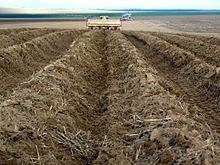
Potato planting in Washington

Potato field in Fort Fairfield, Maine
New tubers may arise at the soil surface. Since exposure to light leads to greening of the skins and the development of solanin, growers are interested in covering such tubers. Commercial growers usually address this problem by piling additional soil around the base of the plant as it grows ("hilling", or in British English "earthing up"). An alternative method used by home gardeners and smaller-scale growers involves covering the growing area with organic mulches such as straw or with plastic sheets.[67]
Correct potato husbandry can be an arduous task in some circumstances. Good ground preparation, harrowing, plowing, and rolling are always needed, along with a little grace from the weather and a good source of water. Three successive plowings, with associated harrowing and rolling, are desirable before planting. Eliminating all root-weeds is desirable in potato cultivation. In general, the potatoes themselves are grown from the eyes of another potato and not from seed. Home gardeners often plant a piece of potato with two or three eyes in a hill of mounded soil. Commercial growers plant potatoes as a row crop using seed tubers, young plants or microtubers and may mound the entire row. Seed potato crops are 'rogued' in some countries to eliminate diseased plants or those of a different variety from the seed crop.
Potatoes are sensitive to heavy frosts, which damage them in the ground. Even cold weather makes potatoes more susceptible to bruising and possibly later rotting, which can quickly ruin a large stored crop.
At harvest time, gardeners usually dig up potatoes with a long-handled, three-prong "grape" (or graip), i.e., a spading fork, or a potato hook, which is similar to the graip but with tines at a 90 degree angle to the handle. In larger plots, the plow is the fastest implement for unearthing potatoes. Commercial harvesting is typically done with large potato harvesters, which scoop up the plant and surrounding earth. This is transported up an apron chain consisting of steel links several feet wide, which separates some of the dirt. The chain deposits into an area where further separation occurs. Different designs use different systems at this point. The most complex designs use vine choppers and shakers, along with a blower system or "Flying Willard" to separate the potatoes from the plant. The result is then usually run past workers who continue to sort out plant material, stones, and rotten potatoes before the potatoes are continuously delivered to a wagon or truck. Further inspection and separation occurs when the potatoes are unloaded from the field vehicles and put into storage.
Immature potatoes may be sold as "New Potatoes" and are particularly valued for taste. These are often harvested by the home gardener or farmer by "grabbling", i.e. pulling out the young tubers by hand while leaving the plant in place.
Potatoes are usually cured after harvest to improve skin-set. Skin-set is the process by which the skin of the potato becomes resistant to skinning damage. Potato tubers may be susceptible to skinning at harvest and suffer skinning damage during harvest and handling operations. Curing allows the skin to fully set and any wounds to heal. Wound-healing prevents infection and water-loss from the tubers during storage. Curing is normally done at relatively warm temperatures 50 °C (122 °F) to 60 °C (140 °F) with high humidity and good gas-exchange if at all possible.[68]
Storage
Storage facilities need to be carefully designed to keep the potatoes alive and slow the natural process of decomposition, which involves the breakdown of starch. It is crucial that the storage area is dark, well ventilated and for long-term storage maintained at temperatures near 4 °C (39 °F). For short-term storage before cooking, temperatures of about 7 °C (45 °F) to 10 °C (50 °F) are preferred.[2][69]On the other hand, temperatures below 4 °C (39 °F) convert potatoes' starch into sugar, which alters their taste and cooking qualities and leads to higher acrylamide levels in the cooked product, especially in deep-fried dishes — the discovery of Acrylamides in starchy foods in 2002 has led to many international health concerns as they are believed to be possible carcinogens and their occurrence in cooked foods are currently under study as possible influences in potential health problems.[70][71]
Under optimum conditions possible in commercial warehouses, potatoes can be stored for up to ten to twelve months.[2] When stored at homes, the shelf life is usually only for several weeks.[69] If potatoes develop green areas or start to sprout, these areas should be trimmed before using.[69]
Commercial storage of potatoes involves several phases: drying of surface moisture; a wound healing phase at 85% to 95% relative humidity and temperatures below 25 °C (77 °F); a staged cooling phase; a holding phase; and a reconditioning phase, during which the tubers are slowly warmed. Mechanical ventilation is used at various points during the process to prevent condensation and accumulation of carbon dioxide.[2]
When stored in the home, mature potatoes are optimally kept at room temperature, where they last 1 to 2 weeks in paper bag, in a dry, cool, dark, well ventilated location.[72] If mature potatoes are refrigerated, dark spots can occur and conversion of starch into sugar can give rise to unpleasant sweet flavour when cooked.[72] Only new potatoes can be refrigerated, and should be kept so, where they have a shelflife of 1 week.[72] If kept in too warm temperatures, both mature and new potatoes will sprout and shrivel.[72] Exposure to light causes them to turn green. Also, potatoes absorb odours produced by pears.[72]
Varieties
While there are close to 4000 different varieties of potato,[73] it has been bred into many standard or well-known varieties, each of which has particular agricultural or culinary attributes. In general, varieties are categorized into a few main groups, such as russets, reds, whites, yellows (also called Yukons) and purples—based on common characteristics. Around 80 varieties are commercially available in the UK.[74] For culinary purposes, varieties are often described in terms of their waxiness. Floury, or mealy (baking) potatoes have more starch (20–22%) than waxy (boiling) potatoes (16–18%). The distinction may also arise from variation in the comparative ratio of two potato starch compounds: amylose and amylopectin. Amylose, a long-chain molecule, diffuses out of the starch granule when cooked in water, and lends itself to dishes where the potato is mashed. Varieties that contain a slightly higher amylopectin content, a highly branched molecule, help the potato retain its shape when boiled.[75]The European Cultivated Potato Database (ECPD) is an online collaborative database of potato variety descriptions, updated and maintained by the Scottish Agricultural Science Agency within the framework of the European Cooperative Programme for Crop Genetic Resources Networks (ECP/GR)—which is organised by the International Plant Genetic Resources Institute (IPGRI).[76]
Popular varieties (cultivars) include:
Blue varieties
The blue potato originated in South America. It has purple skin and flesh, which becomes blue once cooked. It has a slight whitish scab that seems to be present in all samples. The variety, called Cream of the Crop has been introduced into Ireland and has proved popular.[78]A mutation in the varieties' P locus causes production of the antioxidant anthocyanin.[79]
Genetically-modified varieties
Genetic research has produced several genetically modified varieties. 'New Leaf', owned by Monsanto Company, incorporated genes from Bacillus thuringiensis, which conferred resistance to the Colorado potato beetle; 'New Leaf Plus' and 'New Leaf Y', approved by US regulatory agencies during the 1990s, also included resistance to viruses. McDonald's, Burger King, Frito-Lay, and Procter & Gamble announced they would not use genetically modified potatoes, and Monsanto published its intent to discontinue the line in March 2001.[80] The starch content of 'Amflora', waxy potato variety from the German chemical company BASF, has been modified to contain only amylopectin, making it inedible but more useful for industrial purposes. In 2010, the European Commission cleared the way for 'Amflora' to be grown in the European Union. Nevertheless, under EU rules, individual countries have the right to decide whether they will allow this potato to be grown on their territory. Commercial planting of 'Amflora' was expected in the Czech Republic and Germany in spring of 2010, and Sweden and the Netherlands in following years.[81] Another GM potato variety developed by BASF is 'Fortuna'. In 2010, a team of Indian scientists announced they had developed a genetically modified potato with 35 to 60% more protein than non-modified potatoes. Protein content was boosted by adding the gene AmA1 from the grain amaranth. They also found 15 to 25% greater crop yields with these potatoes.[82] The researchers expected that a key market for the GM potato wouuld be the developing world, where more than a billion people are chronically undernourished.[83]New non-GM varieties
Other new potato cultivars are conventionally bred. For example, on 22 September 2007, Benguet State University (BSU) announced that four potato varieties—'Igorota', 'Solibao', 'Ganza' and one not yet officially named—possess more than 18% dry matter content required by fast-food chains to make crispy and sturdy French fries.[84] Since 2005, a natural 100% amylopectin waxy potato variety called 'Eliane' is being cultivated by the starch company AVEBE.Some horticulturists sell chimeras, made by grafting a tomato plant onto a potato plant, producing both edible tomatoes and potatoes. This practice is not very widespread.
Pests
Main article: List of potato diseases
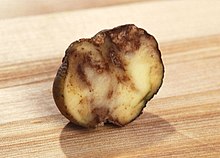
A potato ruined by late blight
Insects that commonly transmit potato diseases or damage the plants include the Colorado potato beetle, the potato tuber moth, the green peach aphid (Myzus persicae), the potato aphid, beetleafhoppers, thrips, and mites. The potato root nematode is a microscopic worm that thrives on the roots, thus causing the potato plants to wilt. Since its eggs can survive in the soil for several years, crop rotation is recommended.
Pesticides
During the crop year 2008, many of the certified organic potatoes produced in the United Kingdom and certified by the Soil Association as organic were sprayed with a copper pesticide[87] to control potato blight (Phytophthora infestans).[88] According to the Soil Association, the total copper that can be applied to organic land is 6 kg/ha/year.[89]According to an Environmental Working Group analysis[90] of USDA and FDA pesticide residue tests performed from 2000 through 2008, 84% of the 2,216 tested potato samples contained detectable traces of at least one pesticide. A total of 36 unique pesticides were detected on potatoes over the 2,216 samples, though no individual sample contained more than 6 unique pesticide traces, and the average was 1.29 detectable unique pesticide traces per sample. The average quantity of all pesticide traces found in the 2,216 samples was 1.602 ppm. While this is a very low value of pesticide residue, it is the highest amongst the 50 vegetables analyzed.
Uses
- Potatoes are used to brew alcoholic beverages such as vodka, potcheen, or akvavit.
- They are also used as food for domestic animals.
- Potato starch is used in the food industry as, for example, thickeners and binders of soups and sauces, in the textile industry, as adhesives, and for the manufacturing of papers and boards.[91][92]
- Maine companies are exploring the possibilities of using waste potatoes to obtain polylactic acid for use in plastic products; other research projects seek ways to use the starch as a base for biodegradable packaging.[92][93]
Culinary uses
Potatoes are prepared in many ways: skin-on or peeled, whole or cut up, with seasonings or without. The only requirement involves cooking to swell the starch granules. Most potato dishes are served hot, but some are first cooked, then served cold, notably potato salad and potato chips/crisps.Common dishes are: mashed potatoes, which are first boiled (usually peeled), and then mashed with milk or yogurt and butter; whole baked potatoes; boiled or steamed potatoes; French-fried potatoes or chips; cut into cubes and roasted; scalloped, diced, or sliced and fried (home fries); grated into small thin strips and fried (hash browns); grated and formed into dumplings, Rösti or potato pancakes. Unlike many foods, potatoes can also be easily cooked in a microwave oven and still retain nearly all of their nutritional value, provided they are covered in ventilated plastic wrap to prevent moisture from escaping; this method produces a meal very similar to a steamed potato, while retaining the appearance of a conventionally baked potato. Potato chunks also commonly appear as a stew ingredient.
Potatoes are boiled between 10 and 25[94] minutes, depending on size and type, to become soft.
Latin America
Peruvian cuisine naturally contains the potato as a primary ingredient in many dishes, as around 3,000 varieties of this tuber are grown there.[95] Some of the more notable dishes include boiled potato as a base for several dishies or with ají-based sauces like in papa a la huancaina or ocopa, diced potato for its use in soups like in cau cau, or in Carapulca with dried potato (papa seca). Smashed condimented potato is used in causa Limeña and papa rellena. French-fried potatoes are a typical ingredient in Peruvian stir-fries, including the classic dish lomo saltado.Chuño is a freeze-dried potato product traditionally made by Quechua and Aymara communities of Peru and Bolivia,[96] and is known in various countries of South America, including Peru, Bolivia, Argentina, and Chile. In Chile's Chiloé Archipelago, potatoes are the main ingredient of many dishes, including milcaos, chapaleles, curanto and chochoca. In Ecuador, the potato, as well as being a staple with most dishes, is featured in the hearty locro de papas, a thick soup of potato, squash, and cheese.
European cuisine
In the UK, potatoes form part of the traditional staple fish and chips. Roast potatoes are commonly served with a Sunday roast, and mashed potatoes form a major component of several other traditional dishes such as shepherd's pie, bubble and squeak, and bangers and mash. New potatoes are often cooked with mint and served with a little melted butter.The Tattie scone is a popular Scottish dish containing potatoes. Colcannon is a traditional Irish food made with mashed potato, shredded kale or cabbage, and onion; champ is a similar dish. Boxty pancakes are eaten throughout Ireland, although associated especially with the north, and in Irish diaspora communities; they are traditionally made with grated potatoes, soaked to loosen the starch and mixed with flour, buttermilk and baking powder. A variant eaten and sold in Lancashire, especially Liverpool, is made with cooked and mashed potatoes.
Bryndzové halušky is the Slovakian national dish, made of a batter of flour and finely grated potatoes that is boiled to form dumplings. These are then mixed with regionally varying ingredients.[97]
In Northern and Eastern Europe, especially in Scandinavian countries, Poland, Russia, Belarus and Ukraine, newly harvested, early ripening varieties are considered a special delicacy. Boiled whole and served un-peeled with dill, these "new potatoes" are traditionally consumed with Baltic herring. Puddings made from grated potatoes (kugel, kugelis, and potato babka) are popular items of Ashkenazi, Lithuanian, and Belarussian cuisine.[98]
In Western Europe, especially in Belgium, sliced potatoes are fried to create frieten, the original French fried potatoes. Stamppot, a traditional Dutch meal, is based on mashed potatoes mixed with vegetables.
In France, the most notable potato dish is the Hachis Parmentier, named after Antoine-Augustin Parmentier, a French pharmacist, nutritionist, and agronomist who, in the late 18th century, was instrumental in the acceptance of the potato as an edible crop in the country. The pâté aux pommes de terre is a regional potato dish from the central Allier and Limousin regions.
In the north of Italy, in particular, in the Friuli region of the northeast, potatoes serve to make a type of pasta called gnocchi.[99] Similarly, cooked and mashed potatoes or potato flour can be used in the Knödel or dumpling eaten with or added to meat dishes all over central and Eastern Europe, but especially in Bavaria and Luxembourg. Potatoes form one of the main ingredients in many soups such as the vichyssoise and Albanian potato and cabbage soup. In western Norway, komle is popular.
A traditional Canary Islands dish is Canarian wrinkly potatoes or papas arrugadas. Tortilla de patatas (potato omelete) and patatas bravas (a dish of fried potatoes in a spicy tomato sauce) are near-universal constituent of Spanish tapas.
North America
In the United States, potatoes have become one of the most widely consumed crops and thus have a variety of preparation methods and condiments. French fries and often hash browns are commonly found in typical American fast-food burger joints and cafeterias. One popular favorite involves a baked potato with cheddar cheese (or sour cream and chives) on top, and in New England "smashed potatoes" (a chunkier variation on mashed potatoes, retaining the peel) have great popularity. Potato flakes are popular as an instant variety of mashed potatoes, which reconstitute into mashed potatoes by adding water, with butter or oil and salt to taste. A regional dish of Central New York, salt potatoes are bite-size new potatoes boiled in water saturated with salt then served with melted butter. At more formal dinners, a common practice includes taking small red potatoes, slicing them, and roasting them in an iron skillet. Among American Jews, the practice of eating latkes (fried potato pancakes) is common during the festival of Hanukkah.A traditional Acadian dish from New Brunswick is known as poutine râpée. The Acadian poutine is a ball of grated and mashed potato, salted, sometimes filled with pork in the center, and boiled. The result is a moist ball about the size of a baseball. It is commonly eaten with salt and pepper or brown sugar. It is believed to have originated from the German Klöße, prepared by early German settlers who lived among the Acadians.
Poutine, by contrast, is a hearty serving of French fries, fresh cheese curds and hot gravy. Tracing its origins to Quebec in the 1950s, it has become a widespread and popular dish throughout Canada.
Indian Subcontinent
In India, the most popular potato dishes are aloo ki sabzi, batata vada, and samosa, which is spicy mashed potato mixed with a small amount of vegetable stuffed in conical dough, and deep fried. Potatoes are also a major ingredient as fast food items, such as aloo chaat, where they are deep fried and served with chutney. In Northern India, alu dum and alu paratha are a favorite part of the diet; the first is a spicy curry of boiled potato, the second is a type of stuffed chapati.A dish called masala dosa from South India is very notable all over India. It is a thin pancake of rice and pulse paste rolled over spicy smashed potato and eaten with sambhar and chutney. Poori in sound India in particular in Tamil Nadu is almost always taken with smashed potato masal. Other favorite dishes are alu tikki and pakoda items.
Vada pav is a popular vegetarian fast food dish in Mumbai and other regions in the Maharashtra in India.
Aloo posto (a curry with potatoes and poppy seeds) is immensely popular in East India, especially Bengal.
Far East Asia
In the Far East, rice still dominates the potato, especially in China and Japan. However, it is used in northern China where rice is not easily grown, with a popular dish being 青椒土豆丝 (qing jiao tu dou si), made with green pepper, vinegar and a thin slices of potato. In the winter, roadside sellers in northern China will also sell roasted potatoes. It is also occasionally seen in Korean and Thai cuisines.[100]Art
The potato has been an essential crop in the Andes since the pre-Columbian Era. The Moche culture from Northern Peru made ceramics from earth, water, and fire. This pottery was a sacred substance, formed in significant shapes and used to represent important themes. Potatoes are represented anthropomorphically as well as naturally.[101]During the late 19th century, numerous images of potato harvesting appeared in European art, including the works of Willem Witsen and Anton Mauve.[102] Van Gogh's 1885 painting "The Potato Eaters" portrays a family eating potatoes.[103]
Invented in 1949 and marketed and sold commercially by Hasbro in 1952, Mr. Potato Head is an American toy that consists of a plastic potato and attachable plastic parts such as ears and eyes to make a face. It was the first toy ever advertised on television.[104]
 Unknown
Unknown
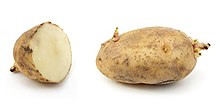






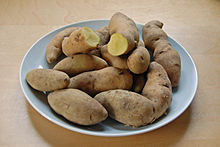


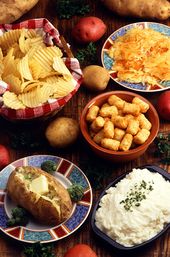

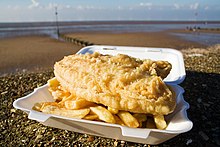
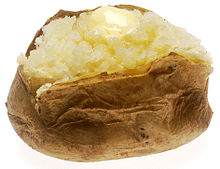

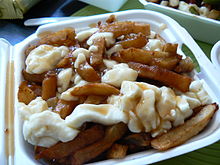











0 komentar:
Post a Comment